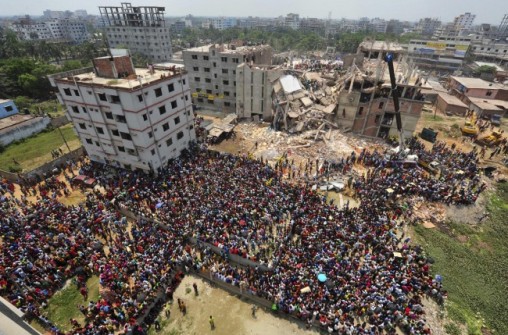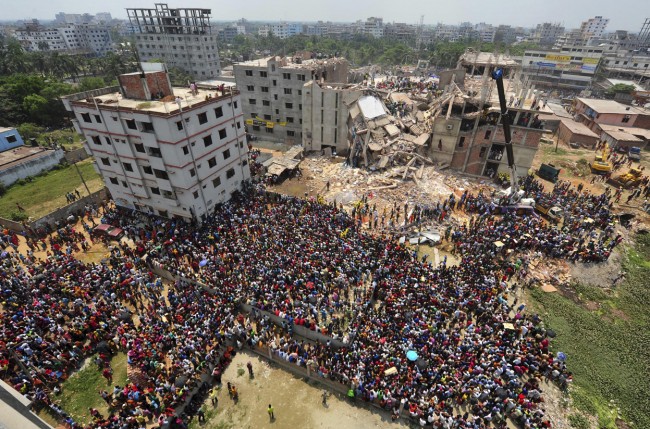By Samone Wheeler
How do you like your clothes? Most would probably answer that they like their clothes comfortable, clean, or fashionable. One thing that people forget to mention is that they like their clothes fast. Nowadays, mainstream clothing is all about fast fashion. At the surface, this means that clothing moves from the runway to retail stores at record speeds. On a deeper level, this means that clothing manufacturers are incentivized to produce clothing as quickly as possible while keeping costs at record lows.
The infamous accident at Rana Plaza demonstrates just how bad fast fashion can be. On April 24, 2013 the eight-story clothing manufacturing building collapsed in Dhaka, Bangladesh, killing over 1000 people and injuring countless others. The building featured several illegal upper floor factories, packed full with employees and heavy power generators. The factory owners depended on the generators to keep production going during frequent power outages. The generators shook the foundation of the building whenever they were in use. On the morning of April 23, the excessive weight finally caused the building to crack. Many employees fled the building in fear that it would collapse. Despite the obvious structural malfunction, overseers ordered employees to return to work the following day. That next morning was business as usual. An employee turned on a generator. The flip of the switch was all it took for the building to buckle and come crashing down.
The Bengali government is largely responsible for this tragedy. Government officials were aware of the deadly conditions in Rana Plaza factory, yet they did little to hold the owners to building code regulations. One government report goes as far to suggest that local officials accepted bribes to ignore the ailing factory.
Clothing retail juggernauts are also to blame. Many global brands from Wal-Mart to Benetton use factories like Rana Plaza for inexpensive labor. They expect their merchandise to be produced quickly and cheaply, often to the detriment of vulnerable employees. In turn, the merchandise is then sold for enormous profits. Companies like this fail to adhere to corporate social responsibility, operating their businesses in a fashion that is out of line with strong moral, social, and environmental policies.
Clearly, there is need for resolution. Withdrawing business from these countries is not the answer. Doing so could cause more harm than good. Bangladesh has become the world’s second largest clothing exporter. The clothing industry has become an integral part of the country’s economy. It accounts for 80% of the country’s total exports and employs nearly 4 million people. The majority of those employees are female. Removing Western retailers would cripple the developing economy and take away the independence that jobs give to women in emergent nations.
Still, continuing to exploit cheap labor employees is not an option. All employees deserve humane treatment. They deserve the right to earn a living wage in a safe and clean environment.
Thankfully, the Rana Plaza tragedy has started to open the eyes of participants in the garment industry. In response to the happening, the United States suspended trade preferences to Bangladesh. During that time, Bangladesh passed several labor laws in support of workers’ rights. The laws allowed the nation to enter the International Labor Organization- International Finance Corporation’s Better Work initiative, a program that provides individualized evaluation and advice to factories. By the same token, some European and American companies formed organizations centered on ensuring that their factories remain up to code and that their workers receive ethical treatment.
Still, garment corporations must be held accountable for their irresponsibility. The steps that a few actors took in the aftermath of a disaster are the exception, not the rule. Worker exploitation is an issue that continues to taint international companies all throughout the world. So, the next time you put on your favorite outfit, ask yourself if it’s worth it. Ask yourself if your clothing is worth the true price of fast fashion.
Sources
Ayres, Alyssa. “A Guide To The Rana Plaza Tragedy, And Its Implications, In Bangladesh.” Forbes. Forbes Magazine, 24 Apr. 2015. Web. 01 July 2015.
“Disaster at Rana Plaza.” The Economist. The Economist Newspaper, 04 May 2013. Web. 29 June 2015.
“Factory Collapse in Bangladesh.” Www.globallabourrights.org. Institute For Global Labour and Human Rights, n.d. Web. 01 July 2015.
O’Connor, Claire. “These Retailers Involved In Bangladesh Factory Disaster Have Yet To Compensate Victims.” Forbes. Forbes Magazine, 26 Apr. 2014. Web. 02 July 2015.
“Pay Up!” Clean Clothes Campaign. Clean Clothes Campaign, n.d. Web. 01 July 2015.
“Who Needs to Pay Up?” Clean Clothes Campaign. N.p., n.d. Web. 26 June 2015.
